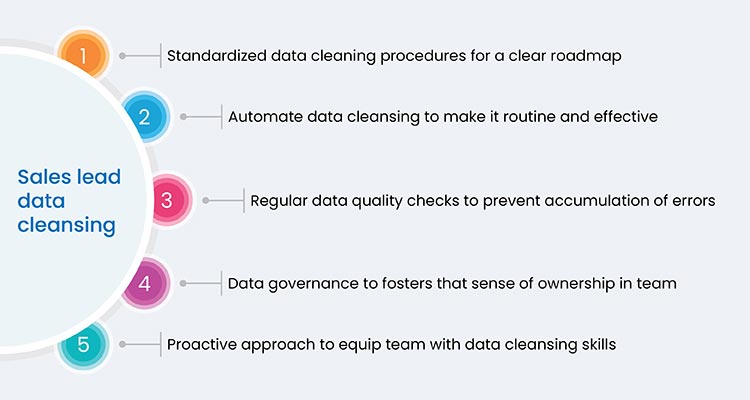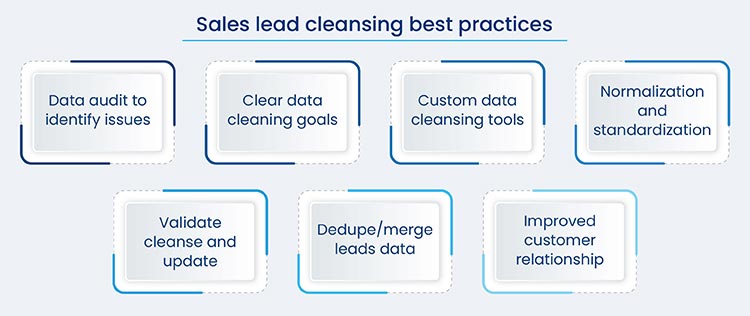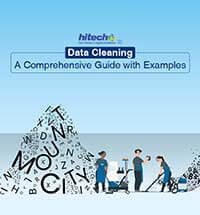Stay Competitive with Our Comprehensive Guide to Data Cleansing!
Accurate marketing data is the key to actionable sales insights and drives customer engagement. Its impact on lead conversion and accuracy of sales forecast ensures profitable growth.
Let me ask this question straight up – are you struggling with inaccurate or duplicate sales lead data?
If so, you’re not alone. After all, in the fast-paced world of sales, the accuracy and quality of your lead data can make or break your success. Many organizations face similar issues, but the good news is that these problems can be effectively managed and even prevented with the right strategies.
Table of Contents
Data cleansing refers to the process of detecting and correcting or eliminating corrupt or inaccurate records from a database. Data cleansing remains a critical aspect of lead management. And it’s not about maintaining a tidy database, it’s about optimizing your sales effectiveness and Customer Relationship Management (CRM) systems. Clean data can significantly enhance your sales team’s efficiency, improve decision-making, and ultimately, boost your bottom line.
But how can you transform data cleansing from a daunting task into a routine process?
The answer lies in adopting best practices that can guide your organization towards a culture of data cleanliness.
Organizations need to adhere to subsequent practices to ensure data cleanliness and accuracy on a regular basis, contributing to a more effective sales process.
Here is an overview of best practices that can transform data cleansing from a sporadic, overwhelming task into a routine, manageable process.

In any organization, consistency is key, especially when it comes to data management. Standardized data cleaning procedures offer a clear roadmap for your team to follow, ensuring that everyone is on the same page. These procedures should outline steps to identify and rectify inaccurate data, the frequency required for completing these tasks, and the responsible parties involved for data cleaning. By establishing these clear guidelines, you can ensure that data cleansing is performed uniformly and regularly across the organization, reducing the risk of errors, inconsistencies, and discrepancies.
Automation is your best friend in this digital age. Automated tools or scripts can streamline data cleansing tasks, making them routine and efficient. These tools can detect and correct errors, remove duplicates, and even standardize data formats. By using automation, you not only save your team valuable time and resources but also minimize the risk of human error.
Prevention is better than cure, and this principle applies to data management as well. Regular data quality checks allow you to identify and address issues promptly, preventing the accumulation of errors and inconsistencies over time. These checks should be conducted periodically, depending on the volume and complexity of your data. By staying proactive, you can ensure the cleanliness and accuracy of your data at all times.
Accountability and ownership are crucial for effective data management. By assigning data governance roles and responsibilities, you can ensure that there is always someone accountable for data cleanliness. This not only fosters a sense of ownership among your team members but also ensures that data issues are addressed promptly and effectively. Remember, data governance is not a one-time task but an ongoing process that requires commitment and diligence.
Knowledge is power, and in the context of data management, it is the key to maintaining clean data. Continuous training and awareness programs can educate your employees on the importance of data cleansing and the best practices to follow. These programs can be in the form of workshops, seminars, or even online courses. By reinforcing these practices, you can cultivate a proactive approach to data cleansing, ensuring that your team is always equipped with the knowledge and skills to maintain data cleanliness.
Cleanse customer data to make your marketing campaigns a success.
Speak to Our Experts →Navigating the world of sales is akin to sailing in a sea of data. However, the presence of inaccurate or duplicate data can muddy the waters, hindering your journey towards successful sales outcomes. Here are seven best practices to cleanse sales lead data that can help you wade through the waters and find the hidden gems that guide you on a successful sales journey.

The first step in the data cleansing process is conducting a thorough data audit. This is crucial for ensuring data accuracy, reliability, and quality. A data audit helps identify potential issues, enabling a targeted approach to data cleansing, which can save time and effort.
Understand your sources
Understanding your data sources, formats, and quality issues is a key part of the audit. This involves assessing the scope and complexity of the data from various sources, such as databases, files, and APIs. Identifying the formats in which the data is stored, such as CSV, Excel, or relational databases, is essential to determine the appropriate cleansing techniques and tools. The audit should also analyze quality issues in the data, such as missing values, inconsistencies, duplicate records, and outliers.
Identify and prioritize cleaning tasks
The next step is to identify and prioritize cleaning tasks based on their potential impact on sales. This involves focusing on critical data attributes that directly affect sales performance, such as customer information, product details, pricing, and transaction records. The significance of each task in improving data accuracy, removing errors, and enhancing the reliability of sales insights should be considered.
Check data at source for errors
Checking data at the source for errors is another important aspect of the audit. This involves conducting statistical analysis to identify patterns and anomalies within the data, which can help detect inconsistencies and potential errors. Implementing data quality checks at the source can minimize the propagation of errors throughout the cleansing process. Common data entry errors, such as misspellings, formatting issues, or incorrect data types, should be identified and rectified to ensure data integrity.
Identify data gaps and outdated information
Finally, the audit should identify data gaps, inconsistencies, and outdated information. This involves identifying areas where necessary information is missing or incomplete, and taking steps to fill those gaps through data enrichment or by obtaining additional data. Inconsistencies within the data, such as conflicting information across different sources or data elements, should be identified. Outdated or obsolete information that may skew analysis or decision-making processes should be identified and removed.

Stay Competitive with Our Comprehensive Guide to Data Cleansing!
Setting clear goals and objectives for data cleaning is akin to setting a destination before embarking on a journey. It gives your data cleaning efforts a clear direction and purpose, ensuring that these efforts are aligned with your broader business objectives. This alignment is crucial as clean, accurate data can significantly enhance decision-making, leading to improved sales outcomes. Moreover, having clear goals allows you to measure progress towards desired outcomes transparently, providing a clear view of your data cleaning journey’s success.
Define criteria for data accuracy, completeness, and quality
Defining criteria for data accuracy, completeness, and quality is like setting the standards for a quality control process. It ensures that your data is free from errors and inconsistencies and that no critical data elements are missing. These criteria serve as predefined standards that your data must meet, offering a measurable benchmark to evaluate the success of your data cleaning efforts. This way, you can ensure that your data is not just clean, but also accurate, complete, and of high quality.
Set specific goals for data cleaning
Every organization could have specific goals for data cleaning that could vary from one to another based on nature of their data. These could include reducing duplicate leads, validating contact information, or segmenting leads based on specific criteria. You might also aim to eliminate common data errors like typos, omissions, or duplications at the source, to significantly streamline the data cleaning process.
You might also need to examine statistical outliers to help flag potential data inaccuracies. Some might have an objective to include tracking patterns of errors to target systematic problems in your data collection or entry process. Preventing the propagation of errors to downstream systems can save time and resources in the long run, making your data cleaning process more efficient and effective.
In the realm of data cleansing best practices, automated tools play a pivotal role. They bring efficiency, accuracy, consistency, and standardization to the process of cleansing sales lead data effectively. Let’s explore some of the key types of tools available in the market:
Data scrubbing tools
These tools are like the ‘cleaning agents’ of your data. They specialize in identifying and correcting errors, inconsistencies, and inaccuracies in datasets. Techniques like pattern matching, fuzzy matching, and data profiling are employed to cleanse and standardize data effectively, contributing to improved data quality in sales lead management.
Deduplication tools
Imagine having multiple copies of the same lead in your database. It’s not just redundant but can also skew your sales analysis. Deduplication tools help identify and remove such duplicate records from datasets. They use sophisticated algorithms and comparison methods to detect, merge, or eliminate duplicate entries, ensuring data integrity and eliminating redundancy.
Data validation tools
These tools act as the ‘quality check’ for your data. They assess the quality and validity of data by checking for adherence to predefined rules, formats, or conditions. Any data that does not meet the specified criteria is flagged and corrected, ensuring data accuracy and compliance with standards.
The advantages of using tailored automated tools, such as those provided by Hitech BPO, are manifold. They not only save time but also enhance accuracy and offer scalability across specific enterprises. By automating the data cleansing process, you can focus more on strategic tasks like lead generation and CRM optimization, while the tools take care of maintaining data hygiene.
Data normalization and standardization are pivotal in the realm of data cleansing. They ensure uniformity and coherence in your data, enabling consistent and accurate analysis.
Normalizing and standardizing data is akin to creating a common language for all your datasets. This process helps achieve uniformity across different datasets by converting data into a common range or format. This uniformity is crucial as it ensures that your analysis and decision-making are based on comparable measurements.
Mitigate skewed results
Just as an outlier in a data set can skew the overall results, skewed distributions, outliers, or extreme values in your data can impact your analysis and statistical modeling. By transforming data to fit a standardized range, you can mitigate the impact of these anomalies, ensuring a more accurate representation of the underlying trends and patterns.
Facilitate model performance
This not only enhances the performance of your models but also enables them to interpret the relative importance of each feature more effectively, leading to more reliable predictions.
Significance of using consistent formats and naming conventions
The use of consistent formats, naming conventions, and data structures is another important aspect of data normalization and standardization. When you’re working with multiple datasets or merging data from different sources, consistent formats and naming conventions ensure smooth data integration.
Enhance data retrieval and querying processes
Using well-defined and standardized naming conventions can help you locate specific variables or attributes within datasets. Consistent data structures, such as the same column headers or data types, facilitate efficient querying and filtering operations.
Ensure simplified data maintenance
Maintaining consistency in your data simplifies data maintenance tasks, making it easier to update, modify, or expand datasets. By applying changes consistently across data, you can reduce errors or inconsistencies during maintenance, contributing to the overall data hygiene in your sales lead management.
In the dynamic world of sales, data is constantly changing. This makes regular data validation and updates a crucial practice in maintaining clean sales lead data.
Importance of ongoing data validation and updates
Imagine trying to navigate a city with an outdated map. You’d likely end up lost or at a dead-end. Similarly, outdated or inaccurate data can lead your sales efforts astray. Regular data validation and updates ensure data accuracy and reliability, maintain data integrity, and prevent the accumulation of outdated data. It’s like constantly updating your map to reflect the latest changes in the city layout, ensuring you always have the most accurate information to guide your journey.
Risks associated with outdated or inaccurate contact information
Outdated or inaccurate contact information in your sales lead data is like dialing wrong numbers. It leads to a breakdown in communication, wasted resources, and misguided marketing efforts. Moreover, reaching out to the wrong audience or providing inaccurate information can negatively impact customer satisfaction and tarnish your brand reputation. It’s like calling a wrong number and insisting that the person on the other end is your long-lost friend. Not only is it embarrassing, but it also damages your credibility.
Validating data is like checking the validity of a passport before a trip. It ensures that your data is accurate, up-to-date, and ready for use. Here are some techniques you can use to validate and verify sales lead data:
Email verification
Employ email verification services or algorithms to validate email addresses for accuracy and deliverability. It’s like checking if the postal address on a letter is correct before sending it out.
Third-party data enrichment
Utilize third-party services or APIs to enrich and validate data by cross-referencing it against reliable sources. It’s like cross-checking the details in a report with multiple sources to ensure accuracy.
Regular data cleansing
Implement scheduled data cleansing routines to identify and correct errors, inconsistencies, and outdated information. It’s like regular house cleaning to keep your home tidy and comfortable.
Data quality monitoring
Deploy monitoring systems to detect anomalies, identify potential data quality issues, and initiate corrective actions. It’s like installing a security system to detect and alert you of any unusual activities.
Innovative techniques like social media data verification or real-time data enrichment can also be used to validate and update data. These techniques are like using the latest gadgets to make your tasks easier and more efficient.
In the realm of sales, duplicate leads are like echoes. They might seem harmless at first, but they can cause inefficiencies, waste resources, and lead to inaccurate reporting and analysis. More importantly, they can be a source of frustration for your customers who may receive multiple, identical communications from your team.
What is negative impact of duplicate leads?
Imagine being in a room full of mirrors. Every action you take is reflected multiple times, creating a confusing and disorienting environment. This is similar to what happens when you have duplicate leads in your sales database. It leads to inefficiencies in your sales process, wasted resources, and can cause frustration for your customers who may receive duplicate communications. Moreover, duplicate leads can skew your reporting and analysis, leading to inaccurate insights and decision-making.
Strategies for identifying and removing duplicate leads
Identifying and removing duplicate leads is like playing a game of ‘spot the difference’. Here are some strategies you can use:
Recently, Hitech BPO assisted an economic advisory firm to develop accurate customer profiles, leveraging our macros and bots to crawl 28,000 records with 80+ fields each to identify, validate and verify dissimilar information of same company and to dedupe marketing data regularly.
Implementing deduplication in an organization is like setting up a new system or process. Here’s how you can do it:
In the world of sales, data hygiene is a fundamental practice that ensures the accuracy and consistency of your sales lead data. It’s a proactive approach that enhances customer relationships, supports informed decision-making, and prevents the accumulation of errors and outdated information.
Maintaining ongoing data hygiene practices is akin to regular maintenance of a high-performance machine. It ensures that your sales lead data, the engine driving your sales efforts, is always in optimal condition, ready to deliver high-quality insights and facilitate effective strategies.
Maintaining data cleanliness requires a systematic and disciplined approach. Here are some actionable strategies:
Training sales teams to enter accurate and complete data is a critical aspect of data hygiene. Here’s how you can implement it:
Maintaining clean sales lead data is a crucial aspect of effective sales and lead generation. The seven best practices outlined in this article—conducting a data audit, defining data cleaning goals, using automated custom data cleansing tools, implementing data normalization and standardization, regularly validating and updating data, deduplicating and merging duplicate leads, and establishing data hygiene practices – provide a comprehensive framework for cleansing sales lead data effectively.
Clean data is the lifeblood of sales effectiveness. It enhances lead generation, optimizes CRM data, and improves sales performance. It ensures accuracy and reliability, enhances customer relationships, supports informed decision-making, and prevents the accumulation of errors and outdated information.
What’s next? Message us a brief description of your project.
Our experts will review and get back to you within one business day with free consultation for successful implementation.
Disclaimer:
HitechDigital Solutions LLP and Hitech BPO will never ask for money or commission to offer jobs or projects. In the event you are contacted by any person with job offer in our companies, please reach out to us at info@hitechbpo.com